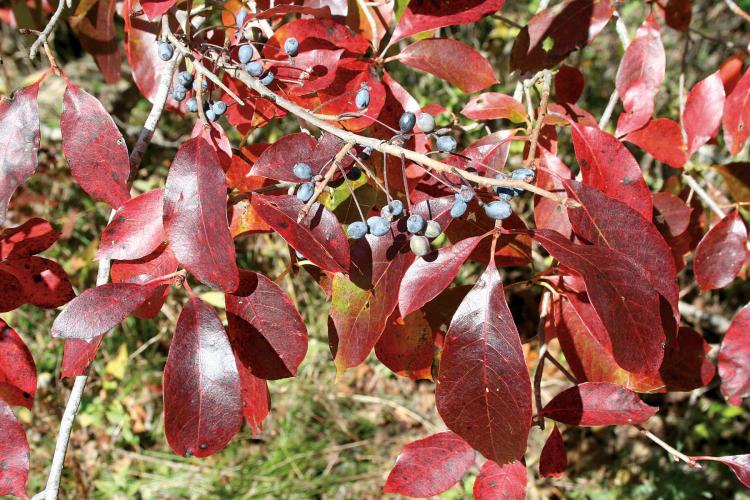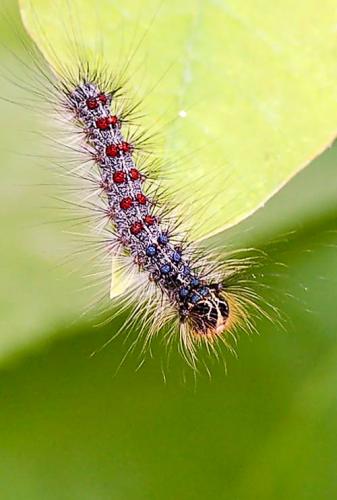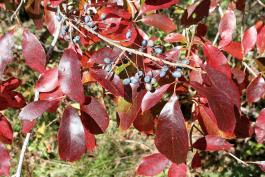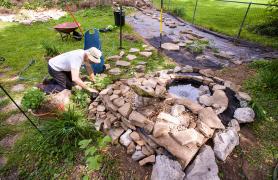We love trees — especially the ones in our yards.
For many of us, trees bring back fond memories of tire swings, treehouses, and shaded backyard afternoons. We play in their fallen leaves in autumn, string festive lights on them in winter, and look forward to our trees waking up each spring. We want our trees to live forever, so when something doesn’t look quite right, we become concerned.
Trees and people have at least one thing in common — both experience stress. Tree stress is often related to environmental conditions such as drought, extreme weather, and poor soil. Once weakened by stress, trees are more susceptible to serious insect and disease issues. However, much of what we notice, leaf galls and spots or light insect feeding, are only minor stressors for an otherwise healthy tree.
Unfortunately, trees growing in yards can suffer from a much more familiar cause of stress — us. We tend to overlook major stressors, like construction damage, soil compaction, and lawn care chemicals, which end up being the real tree killers. Even the fertilizing, mulching, and pruning we do to “help” our trees can cause serious problems if done improperly. How can you help keep your trees healthy? The good news is that you can reduce tree stress by using good tree care practices such as proper watering, mulching, and pruning. Read on to learn more about good tree care and what may, or may not, be killing your tree.
Plant Native Trees!
Many tree species native to Missouri make great yard trees. Why? Native trees are well-adapted to our soils and climate, provide benefits to wildlife, and won’t become invasive. There are many species to choose from, so it is important to consider the characteristics of your yard and select a tree that will thrive in those conditions. Be sure to plant your tree properly. Trees planted too deep do not grow well and may develop root issues in the future. For more information on selecting and planting native trees, visit mdc.mo.gov/trees-plants/tree-care.
- Overcup oak: Large tree tolerant of wet or flood-prone soils; acorns provide winter food for deer and squirrels.
- Black gum: Medium sized tree with brilliant red fall color; fruits eatenby over 30 bird species.
- Pawpaw: Small shade-loving tree that produces edible fruit in early fall; host for zebra swallowtail caterpillars.
What’s Not Killing Your Tree
Leaf-Feeding Insects
Native leaf-feeding insects such as caterpillars and sawfly larvae rarely cause problems for healthy trees and are an important food source for wildlife. Outbreaks of these leaf feeders occur periodically but are controlled by natural enemies within a year or two. However, insect injury in early spring or on evergreens can be more damaging and may require management.
Mulch
Mulch helps keep tree roots healthy by moderating soil temperature and moisture. The wider the mulch ring, the more roots that benefit from it. When applying mulch, use a 3-inch layer of wood chips or shredded bark.
Never mound mulch around a tree because this sets the stage for insect and disease problems, root rot, and tree decline.
Leaf Spots and Galls
Leaf spots and galls can be quite striking in appearance — and often alarming for a tree owner. Galls are typically formed as a response to insect activity. Leaf spots are commonly caused by fungi and are often brought on by wet or humid weather. The good news is that most galls and spots cause little damage to a healthy tree, so treatments are rarely needed.
Yellow-bellied Sapsucker
Yellow-bellied sapsuckers are small woodpeckers that feed on sap from shallow holes they drill in trees in the fall and winter. These holes, called sap wells, are often in groups or rows and may be round or rectangular. Healthy trees can callus over sapsucker injury in a few years.
Horned Oak Gall
Horned oak galls are tough, woody growths often found on pin oak branches. They are caused by a tiny, stingless wasp native to Missouri. These galls are unsightly and cause tree stress but aren’t considered tree killers. Currently, no effective tree treatments are available, so practice good tree care to reduce stress on your tree.
Water
Water is critical to keeping a tree healthy. Drought weakens a tree’s defenses, making it more susceptible to insects and diseases. Avoid tree stress by watering two to three times per month during dry periods. A good recommendation is 10 gallons of water per inch of trunk diameter.
What Is Killing Your Tree
Poor Pruning
Improper pruning practices, such as topping, can create stressed, hazardous trees with shortened lifespans. When done correctly, pruning is an important part of good tree care. Make pruning cuts just outside the branch collar, the area at the base of the branch specialized for callusing over wounds. Most pruning should be done in winter when trees are dormant. While tree wound spray is generally not recommended, it should be used if oaks are pruned in March through June to prevent oak wilt.
Hypoxylon Canker
Hypoxylon canker is a native fungal disease that commonly affects trees stressed by drought or construction damage. This disease causes dead areas under a tree’s bark. Eventually, the bark falls off, revealing fungal mats that look like tan or gray paint. Trees with hypoxylon canker dry out quickly, making them brittle and potentially hazardous. Contact a certified arborist if you see signs of this disease on your tree. You can help prevent hypoxylon canker by watering your tree during drought.
Lawn Care Practices
What’s good for grass isn’t always good for trees. Many popular lawn care products can damage a tree’s root system, causing tree stress and decline. Avoid using herbicides to control weeds or brush within the root zone of your tree. Turf fertilizers high in nitrogen can burn tree roots and cause unhealthy growth. Most trees need soil that is slightly acidic to properly absorb nutrients. Soil tests are affordable and easy to do, so have your soil analyzed before applying fertilizers or pH adjusters. If you hire a lawn care service, be sure to ask what products they use.
Root Damage
When planning construction activities, keep your trees in mind! Common construction practices often result in root damage that leads to tree death. Tree root systems extend far beyond the edge of the canopy, with most roots growing in the top 18 inches of soil. These shallow roots are damaged when heavy equipment compacts soil, reducing the availability of air and water. Adding soil around established trees can also suffocate root systems. Installing pavement or trenching near a tree can cut off a large number of roots. You may not see root damage, but affected trees often slowly decline and die within 10 years.
Insect Borers
Think of native insect borers as nature’s recyclers, coming in to help break down dying trees. Borers tunnel into trees, leaving behind winding trails in the wood and holes in the bark. Unfortunately, insect borer activity can be a sign that your tree is stressed. You may be able to help your tree overcome borers through watering and practicing good tree care. Some insect borers can be effectively managed with an insecticide, but accurate pest identification and treatment timing are critical.
Tree Wounds
Tree bark isn’t as tough as it looks. Even small wounds, like those caused by mowers and string trimmers, often lead to future problems. Decay-causing fungi gain entry through wounds and can create hollow areas that weaken a tree’s structure over time. Mushrooms growing from the trunk or roots of your tree are a sign of internal decay. Trees with wounds or mushrooms are potentially hazardous and should be evaluated by a certified arborist.
Be on the Lookout
Most people have heard of the emerald ash borer, an invasive wood-boring insect that was originally brought to Missouri in ash firewood. Unfortunately, this isn’t the only tree killer that can hitch a ride with humans. New pests are introduced to the U.S. every year through global trade. Once established in the local environment, these pests are easily moved long distances by people. Read on to learn more about three pests that are currently threatening our trees. Don’t be the one to accidentally bring these bad bugs to your neighborhood!
Asian Longhorned Beetle
- Travels in firewood and pallets
- Bores into many common yard trees — prefers maples
- Look for large round holes in tree bark
Gypsy Moth
- Travels on vehicles and outdoor gear
- Strips leaves from oaks and many other trees
- Look for tan, fuzzy egg masses
Spotted Lanternfly
- Travels on any smooth surface, from landscaping stone to patio furniture
- Sucks sap from many trees and plants
- Look for large spotted insects, often in groups
Report sightings of these insects to Forest.Health@mdc.mo.gov.


















Also In This Issue


And More...
This Issue's Staff
Associate Editor - Larry Archer
Staff Writer - Bonnie Chasteen
Staff Writer - Heather Feeler
Staff Writer - Kristie Hilgedick
Staff Writer - Joe Jerek
Creative Director - Stephanie Thurber
Art Director - Cliff White
Designer - Les Fortenberry
Designer - Marci Porter
Photographer - Noppadol Paothong
Photographer - David Stonner
Circulation - Laura Scheuler






















